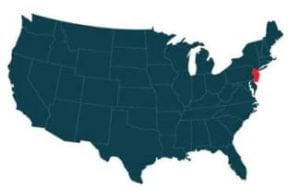New Jersey Emergency Vehicle Light State Statutes
New Jersey state law specifies emergency vehicle lighting policy. State laws and regulations also specify how other vehicles can respond to emergency lights in a safe and lawful manner on major roadways.
Police Lights
New Jersey Statute 39:4-92.1 dictates that the police in New Jersey can use blue or red police lights in any setup.
Fire Truck Lights
New Jersey state law dictates the red flashing lights must be used by fire trucks. Those lights have to be visible from 500 feet away.
Volunteer Fire Fighter Lights
Blue Lights – According to 39:3-54.7, active members of the volunteer fire company who remain in good standing can operate blue emergency lights when responding to a fire or an emergency call. Displaying this light does not mean drivers are exempt from normal traffic patterns and must abide by regular laws and regulations on traffic. Civil vehicle drivers have to legally yield to these lights.
Red Lights – In response to a fire or an emergency call, active volunteer fire chiefs or first assistant volunteer fire chiefs are able to display red light. Displaying these lights doesn’t change the traffic patterns that vehicles have to follow legally, but civilian drivers have to yield to the red light.
Ambulance Lights
Emergency lights may only be displayed when the vehicle is driving in an emergency or when a patient is transported requiring immediate medical care or is determined to need immediate medical assistance quickly. Drivers have to give in to let ambulances pass. Ambulances should be using red, flashing lights.
Tow Truck Lights
A tow truck must have the requisite authorisation to show a sign. One blinking amber light on the vehicle has to be visible from any direction. The blinking light can only be shown while towing the car.
Construction Vehicle Lights
New Jersey Law under 39A:LRS-1 permits construction workers to use lamps, reflectors and specialized lights for their safety and the safety of other road drivers. Lighted lamps must be used half an hour after sunset, half an hour before sunrise, and under weather conditions that restrict visibility. Drivers on the road must be able to see light from 500 feet away. Under 39:3-54 it is stated that for a vehicle to be able to legally display any kind of flashing light, a permit is required. The permit issued will be precise about the form and color of the light which can be used. The color of the flashing lights that can be displayed at this time is a white and amber flashing, or a shade that is somewhere in between the shades of white and amber. These lights are intended to serve as a warning to drivers of a future construction hazard. The lights are on the same level and have to be lined out in a large range.
Utility Vehicle Lights
Utility vehicles are legally capable of displaying red warning lights within the State boundaries of New Jersey. The red lights must be visible from a distance of 500 feet when displayed. That is only when New Jersey law enforcement deems this necessary.
Pilot Vehicle Lights
New Jersey does not have any stipulated legislation for lighting on pilot vehicles at this time. A pilot vehicle is defined as a vehicle used to escort another vehicle carrying a large or oversized charge.
Security Vehicle Lights
If a vehicle wishes to display any kind of light, they must first obtain a permit through the State. A vehicle cannot legally display any lights of any kind without a permit, even if the vehicle is being used for safety purposes.
Other emergency light information
The Chief Administrator may approve other sources of strobe lighting in the event of an emergency or road hazard. This could be flares burning with liquid or red electric lanterns. There may also be use of portable red emergency reflectors in case of emergency. It is important to refer back to the state legislation and guidelines before purchasing a light of any kind for your vehicle. Such guidelines as identified in this article relate only to the New Jersey state and may not be the same as other states. The safest choice when seeing an emergency light on the road is the yield, and be aware of the other vehicles around you.
For more information on what lights are available to you, we suggest calling your State Highway Patrol office at: 609-882-2000
*Please note that these numbers are what we can find at the moment, and the numbers may have changed since this listing.


